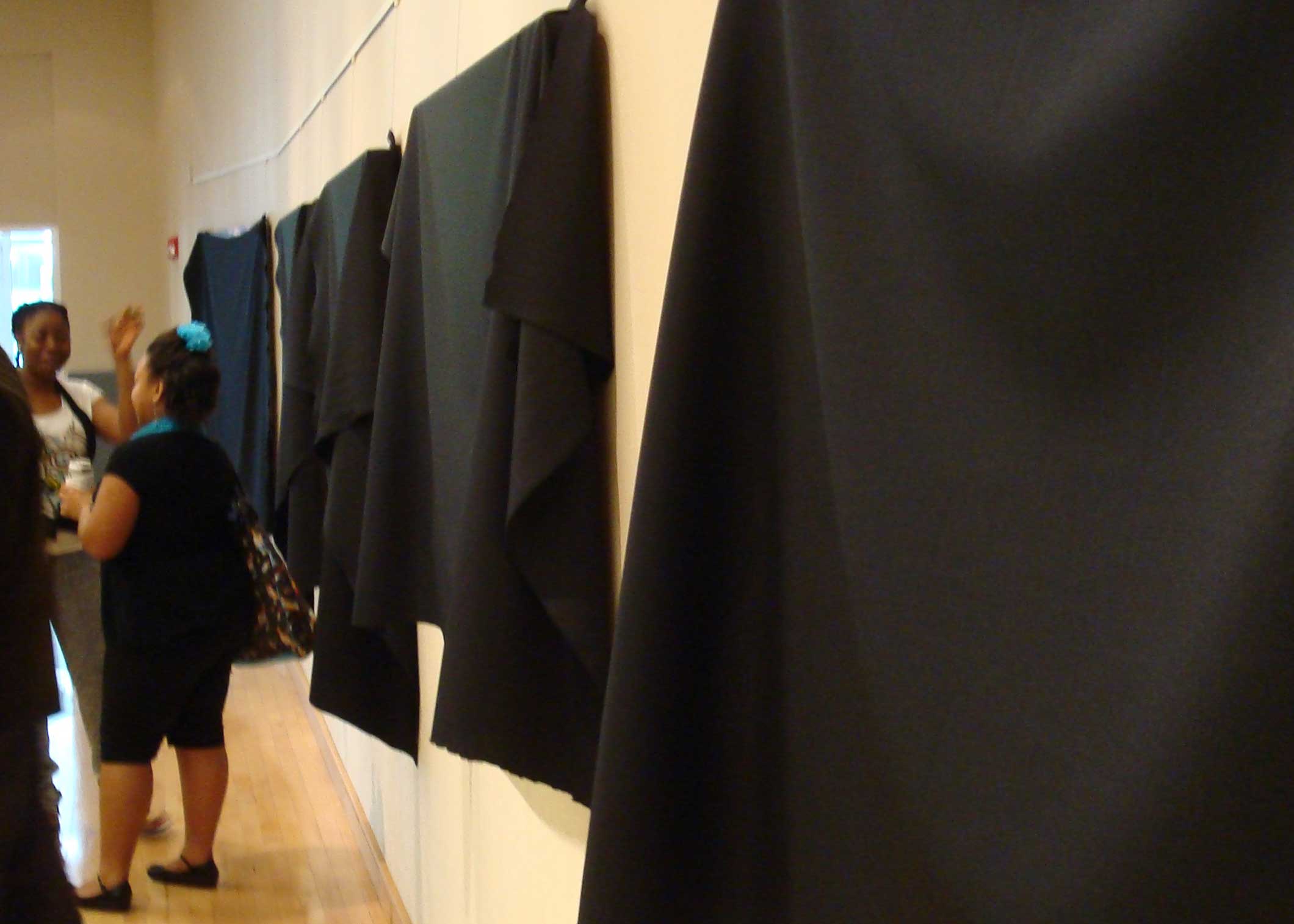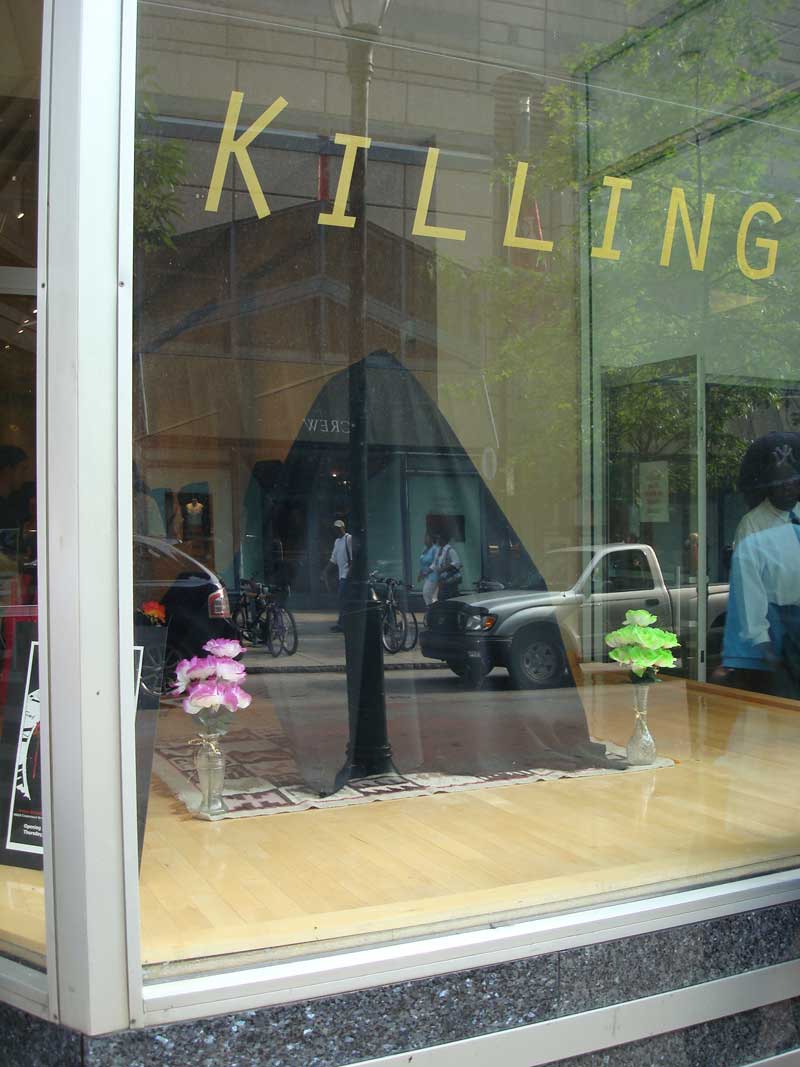on
“'Killing Time' part 2: I WAS THERE!

Last night, I made it out to the student-curated show of “Killing Time” at The Art Institute Gallery. All of the art work really had been covered in black drapes.
From the Philadelphia Weekly’s On-Line Coverage of “Killing Time” yesterday:
Just as the witch doctor or the tribal wise woman makes an image of the evil that needs to be eradicated and destroy (in the superstitious belief that this would make the real evil go away), so modern conservatives—absolutely convinced none of our problems could possibly be systemic—are forever casting around for images of evil to ban or destroy, in the magical belief that this will somehow eradicate evil in the real world.
The problem of gun violence seems enormous, but the solution is blindingly simple: Forget gun control, eradicating poverty, using suburban taxes to improve inner city schools, ending the segregation that blights all big American cities. Let’s just get rid of all the horrid films and books and games and—poof!—all the nasty things in the real world will disappear as well.
Honest.
I spoke to Steven Earl Weber, the aggrieved artist, and David Kessler, the Organizer of the protest. The sense you got from both of them was that they knew how badly the university had screwed up and that — particularly from the perspective of the larger art world — they were both really on the side of the angels. It was from PW’s coverage (linked above), that I learned just how hard Weber had tried to talk to The Art Institute’s President Larkin, even going so far as to sit outside his office for four hours in hopes of a conversation.
Denied. If he’s not too smart to regret that move now, then he probably isn’t smart enough to be running a school.
The artists invited into this show were: Lauren Rossi, Tommy Reynolds, Katherine Kesselring, Joan Smith, and Jaime Alvarez. In a very short amount of time, they were all able to agree on a course of action and endorse the letter from David Kessler. I think this is an impressive show of resolve and solidarity on the artists’ part and I hope they will all feel proud of this evening for a good long time.
The piece that they showed draped last night clearly wasn’t the original, which looked a lot like the one I showed a photo of in my prior post about this flap. Weber removed it after it was censored for fear that it would be damaged if Art Institute staff tried to move it themselves.
Here’s what we saw in the gallery’s front window last night:

I am sure folks who walked by wondered what was going on.
The feel inside the gallery was ebullient. No signs of school administration there to squelch the talk of uprising. No sense that anyone felt like they’d been caught out doing wrong. Usually, art openings are pretty low energy affairs, but this wasn’t. Old art world friends were out, chatting with each other, laughing, enjoying their shared righteous indignation, secure in the knowledge that this was one the good guys would ultimately win.
In fact, they already have. Weber and Kessler have gotten more attention out of this than they ever would have if the show had been left alone. Now, they are both Philadelphia art heroes. Ironically, “Glorified” is sure to be seen by far more people now than it ever would have otherwise, and story of The Art Institute’s bad call is going to go with the piece wherever it travels in person or on-line from here on out.
The folks I feel worst for in this story are the young people who put the show together. With 32 curators, I couldn’t really figure out how to discern which of the students present had decided what kind of show to run. Undoubtedly, some of them were really upset when the President censored “Glorified.” There were bound to be students who freak out if they feel like they “did something wrong.” It’s not a feeling that helps a young artist develop. I bet even more of them felt worse when the rest of the artists decided to cover their work in solidarity with Weber. That’s certainly not to say that that the artists didn’t make the right decision — they did — I just bet it was unsettling for some of the curators.
Undoubtedly, many of the students behind the show got it, but I know from three years full time experience with college students working on issues just like this that sometimes when the hammer comes down on you, even when it comes down on you for standing up for what’s right, some folks still come out feeling like they did wrong.
It’s an awful feeling. Weber’s going to be okay, but the young people who’s hard work to put this show together (can you imagine how hard it would be for 32 college students to decide on a set of art work that they would like to exhibit must have been?) got quashed by the small-mindedness of President Larkin really are victims in this story. Hopefully, most of them see this as a great learning experience and an art world battle scar they can brag about for years to come at a hundred happy hours and First Fridays to come.
For some of them, though, I have no doubt, this just really sucks. That’s not cool. Hopefully, they see it differently later. They accomplished what everyone in the art world wants to do and usually fails at. They pushed buttons and they got a reaction.
The action is in the reaction, so I say “good job.”
Someday, God willing, they will all be able to tell themselves the same thing.